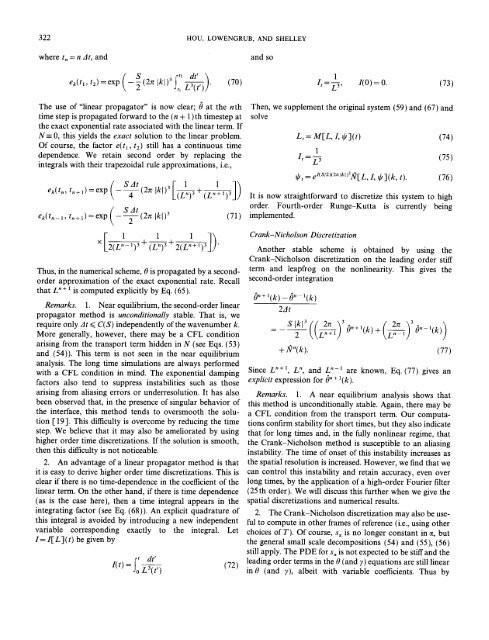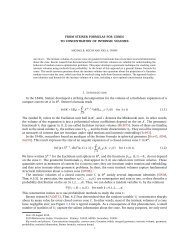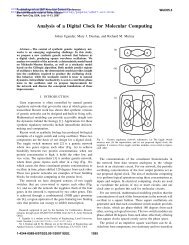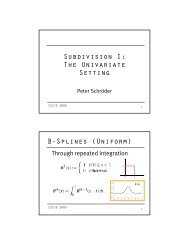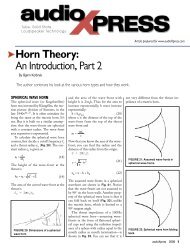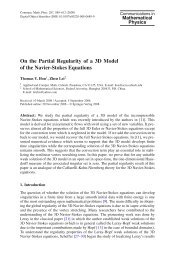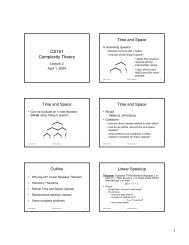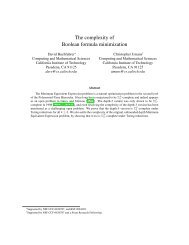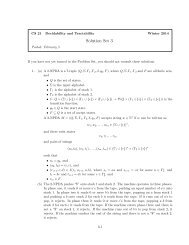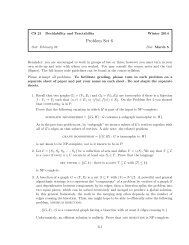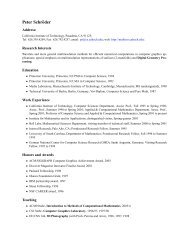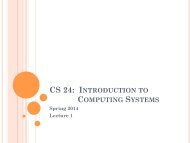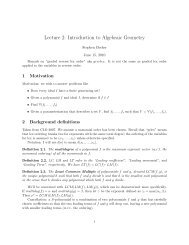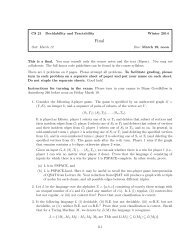Removing the Stiffness from Interfacial Flows with Surface Tension
Removing the Stiffness from Interfacial Flows with Surface Tension
Removing the Stiffness from Interfacial Flows with Surface Tension
Create successful ePaper yourself
Turn your PDF publications into a flip-book with our unique Google optimized e-Paper software.
322 HOU, LOWENGRUB, AND SHELLEYwhere t. = n At, andand soS t2 dt' "]ek(tl, tz) = exp -- ~ (2zr ]kl) 3 ft, za(t')J" (70)The use of "linear propagator" is now clear; 0 at <strong>the</strong> n thtime step is propagated forward to <strong>the</strong> (n + 1 )th timestep at<strong>the</strong> exact exponential rate associated <strong>with</strong> <strong>the</strong> linear term. IfN-0, this yields <strong>the</strong> exact solution to <strong>the</strong> linear problem.Of course, <strong>the</strong> factor e(tl, t2) still has a continuous timedependence. We retain second order by replacing <strong>the</strong>integrals <strong>with</strong> <strong>the</strong>ir trapezoidal rule approximations, i.e.,1ek(t., tn+l)=exp (-S~t(21r lkl)3[(~ ~ (Ln~- 1)3])SAtek(tn_l, tn+l)=exp -----~-(2/l:lkl) 3 (71)- 1X _2( Ln _ 1 ) 3Thus, in <strong>the</strong> numerical scheme, 0 is propagated by a secondorderapproximation of <strong>the</strong> exact exponential rate. Recallthat L" +1 is computed explicitly by Eq. (65).Remarks. 1. Near equilibrium, <strong>the</strong> second-order linearpropagator method is unconditionally stable. That is, werequire only d t ~< C(S) independently of <strong>the</strong> wavenumber k.More generally, however, <strong>the</strong>re may be a CFL conditionarising <strong>from</strong> <strong>the</strong> transport term hidden in N (see Eqs. (53)and (54)). This term is not seen in <strong>the</strong> near equilibriumanalysis. The long time simulations are always performed<strong>with</strong> a CFL condition in mind. The exponential dampingfactors also tend to suppress instabilities such as thosearising <strong>from</strong> aliasing errors or underresolution. It has alsobeen observed that, in <strong>the</strong> presence of singular behavior of<strong>the</strong> interface, this method tends to oversmooth <strong>the</strong> solution[ 19]. This difficulty is overcome by reducing <strong>the</strong> timestep. We believe that it may also be ameliorated by usinghigher order time discretizations. If <strong>the</strong> solution is smooth,<strong>the</strong>n this difficulty is not noticeable.2. An advantage of a linear propagator method is thatit is easy to derive higher order time discretizations. This isclear if <strong>the</strong>re is no time-dependence in <strong>the</strong> coefficient of <strong>the</strong>linear term. On <strong>the</strong> o<strong>the</strong>r hand, if <strong>the</strong>re is time dependence(as is <strong>the</strong> case here), <strong>the</strong>n a time integral appears in <strong>the</strong>integrating factor (see Eq. (68)). An explicit quadrature ofthis integral is avoided by introducing a new independentvariable corresponding exactly to <strong>the</strong> integral. LetI= I[L](t) be given byI(t)= fo1dt'L3(t,) (72)1I t = L--- 3, I(0) = 0. (73)Then, we supplement <strong>the</strong> original system (59) and (67) andsolveL, = M[L, I, ~k](t) (74)1I, =~--~ (75)~k, = eZ(S/2)~z~lkl)3b~[ L, L ~b](k, t). (76)It is now straightforward to discretize this system to highorder. Fourth-order Runge-Kutta is currently beingimplemented.Crank-Nicholson DiscretizationAno<strong>the</strong>r stable scheme is obtained by using <strong>the</strong>Crank-Nicholson discretization on <strong>the</strong> leading order stiffterm and leapfrog on <strong>the</strong> nonlinearity. This gives <strong>the</strong>second-order integrationO°+l(k)--O° l(k)2At+ A?"(k). (77)Since L n+l, L n, and L n-1 are known, Eq. (77) gives anexplicit expression for O n + l(k).Remarks. I. A near equilibrium analysis shows thatthis method is unconditionally stable. Again, <strong>the</strong>re may bea CFL condition <strong>from</strong> <strong>the</strong> transport term. Our computationsconfirm stability for short times, but <strong>the</strong>y also indicatethat for long times and, in <strong>the</strong> fully nonlinear regime, that<strong>the</strong> Crank-Nicholson method is susceptible to an aliasinginstability. The time of onset of this instability increases as<strong>the</strong> spatial resolution is increased. However, we find that wecan control this instability and retain accuracy, even overlong times, by <strong>the</strong> application of a high-order Fourier filter(25 th order). We will discuss this fur<strong>the</strong>r when we give <strong>the</strong>spatial discretizations and numerical results.2. The Crank-Nicholson discretization may also be usefulto compute in o<strong>the</strong>r frames of reference (i.e., using o<strong>the</strong>rchoices of T). Of course, s~ is no longer constant in ~, but<strong>the</strong> general small scale decompositions (54) and (55), (56)still apply. The PDE for s, is not expected to be stiff and <strong>the</strong>leading order terms in <strong>the</strong> 0 (and y) equations are still linearin 0 (and y), albeit <strong>with</strong> variable coefficients. Thus by


